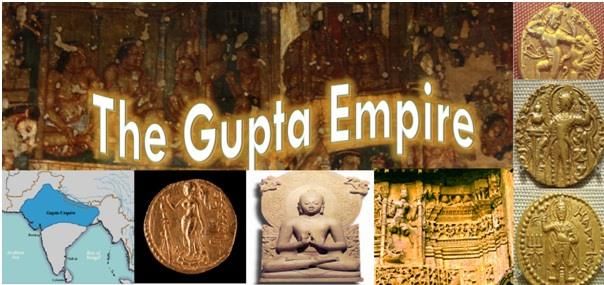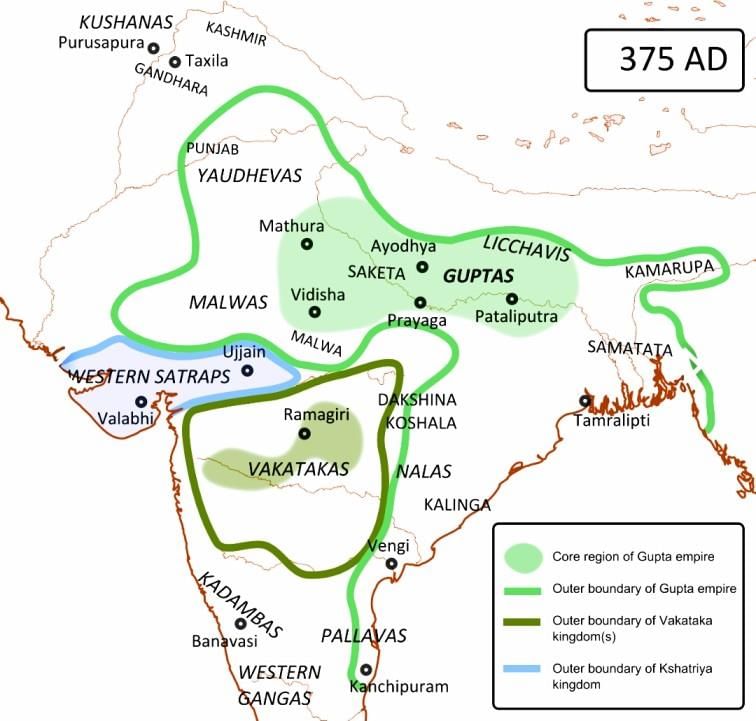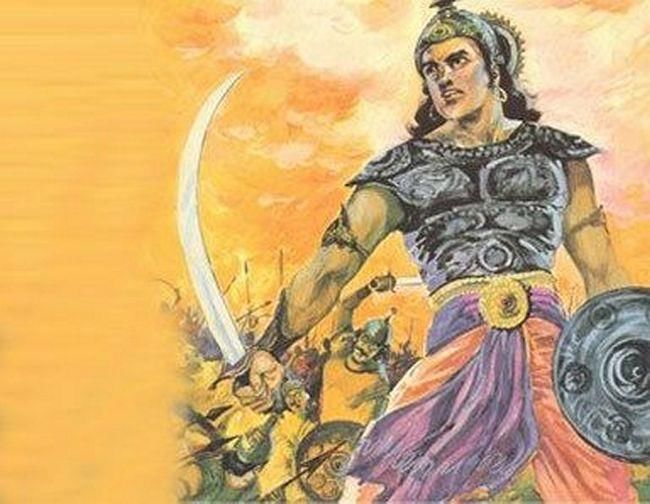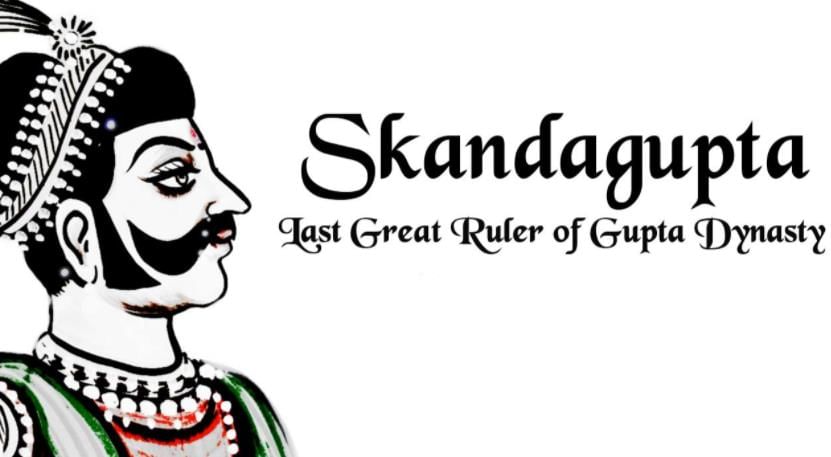UPSC Exam > UPSC Notes > History for UPSC CSE > Old NCERT Summary (RS Sharma): Rise and Growth of the Gupta Empire
Old NCERT Summary (RS Sharma): Rise and Growth of the Gupta Empire | History for UPSC CSE PDF Download
The Rise and Growth of The Gupta Empire
Background
- After The break-up of the Maurya empire, the Satavahanas and the Kushans emerged as two large political powers. The Satavahanas acted as a stabilizing factor in the Deccan and south to which they gave political unity and economic prosperity on the strength of their trade with the Roman empire. The Kushans performed the same role in the north. Both these empires came to an end in the middle of the third, century A.D.
- On the ruins of the Kushan empire arose a new empire, which established its way over a good part of the former dominions of both the Kushans and Satavahanas. This was the empire of the Guptas, who may have been of vaishya origin. Although the Gupta empire was not as large as the Maurya empire, it kept north India politically united for more than a century from A.D. 335 to 455.

- The original kingdom of the Guptas comprised Uttar Pradesh and Bihar at the end of the third century A.D. Uttar Pradesh seems to have been a more important province for the Guptas than Bihar because early Gupta coins and inscriptions have been mainly found in that state.
- If we leave out some feudatories and private individuals, whose inscriptions have been mostly found in Madhya Pradesh, Uttar Pradesh will stand out as the most important area in respect of the finds of the Gupta antiquities. Hence, Uttar Pradesh seems to have been the place from where the Guptas operated and fanned out in different directions. Probably with their center of power at Prayag they spread in the neighboring regions.
- The Guptas were possibly the feudatories of the Kushans in Uttar Pradesh and seems to have succeeded them without any wide time lag. At many places in Uttar Pradesh and Bihar, the Kushan antiquities were immediately followed by the Gupta antiquities.

- It is likely that the Guptas learned the use of a saddle, reins, buttoned coats, trousers, and boots from the Kushans. All these gave them mobility and made them excellent horsemen. In the Kushan scheme of things, horse-chariots and elephants had ceased to be important.
- Horsemen played the main part. This also seems to have been the case with the Gupta on whose coins horsemen are represented. Although some Gupta kings are described as excellent and unrivaled chariot warriors, their basic strength lay in the use of horses.
- The Guptas enjoyed certain material advantages. The center of their operations lay in the fertile land of Madhyadesha covering Bihar and Uttar Pradesh. They could exploit the iron ores of central India and south Bihar. Further, they took advantage of their proximity to the areas in north India which carried on silk trade with the Eastern Roman Empire, also known as the Byzantine empire.
- On account of these favorable factors, the Guptas set up their rule over Anuganga (the middle Gangetic basin), Prayag (modern Allahabad), Saketa (modern Ayodhya), and Magadha. In course of time, this kingdom became an all-India empire.
- The Kushan power in north India came to an end around A.D. 230 and then a good part of central India fell under the rule of the Murundas, who were possibly the kinsmen of the Kushans. The Murundas continued to rule till A.D. 250. Twenty-five years later, in about A.D. 275, the dynasty of the Gupta came to power.
Chandragupta I (A.D. 319-334)
- The first important king of the Gupta dynasty was Chandragupta I. He married a Lichchhavi princess most probably from Nepal, which strengthened his position. The Guptas were possibly vaishyas, and hence marriage in a Kshatriya family gave them prestige.
- Chandragupta I seems to have been a ruler of considerable importance because he started the Gupta era in A.D. 319-20, which marked the date of his accession. Later many inscriptions came to be dated in the Gupta era.
Samudragupta (A.D. 335-380)
Samudragupta
- The Gupta kingdom was enlarged enormously by Chandragupta I’s son and successor Samudragupta (A.D. 335-380). He was the opposite of Ashoka. Ashoka believed in a policy of peace and son-aggression, but Samu Dasgupta delighted in violence and conquest. His court poet Harishena wrote a glowing account of the military exploits of his patron.
- Along with the inscription, the poet enumerates the peoples and countries that were conquered by Samudragu PTA. The inscription is engraved at Allahabad on the same pillar which carries the inscriptions of the peace-loving Ashoka.
- The places and the countries conquered by Samudragupta can be divided into five groups:
- Group one includes princes of the Ganga-Yamuna doab who were defeated and whose kingdoms were incorporated into the Gupta empire.
- Group two includes the rulers of the eastern Himalayan states and some frontier states such as princes of Nepal, Assam, Bengal, etc., who were made to feel states and some frontier states such princes of Nepal, Assam, Bengal, etc., who were made to feel the weight of Samudraguptas arms. It also covers some republics of Punjab, The republic, which flickered on the ruins of the Maurya empire, were finally destroyed by Samudragupta.
- Group three includes the forest kingdoms situated in the Vindhya region and known as Atavika rays, they were brought under the control of Samudragupta.
- Group four includes twelve rulers of the eastern. Deccan and south India, who were conquered and liberated. Samudragupta’s arms reached as far as Kanchi in Tamil Nadu, where the Pallavas were compelled to recognize his suzerainty.
- Group five includes the names of the Sanka's and Kushans, some of them ruling in Afghanistan.
- It is said that Samudragupta swept them out of power and received the submission of the rulers of distant lands. The prestige and influence of Samudragupta spread even outside India. According to a Chinese source, Meghavarman, the ruler of Sri Lanka, sent a missionary to Samudragupta for permission to build a Buddhist temple at Gaya. This was granted, and the temple was developed into a huge monastic establishment.
- If we believe the eulogistic inscription from Allahabad, it would appear that Samudragupta never knew any defeat, and because of his bravery and generalship, he is called the Napoleon of India. There is no doubt that Samudragupta forcibly unified the greater part of India under him, and his power was felt in a much larger area.
Chandragupta II (A.D. 380-412)
- The reign of Chandragupta II saw the high watermark of the Gupta empire. He extended the limits of the empire by marriage alliances and conquests. Chandragupta married his daughter Prabhavati to a Vakata ka prince who belonged to the brahmana caste and ruled in central India.
- The prince died and was succeeded by his young son. So Prabhavati became the virtual paler. As shown by some of her land charters, which betray the influence of the eastern Gupta writing, she promoted the interests of her father Chandragupta.
- Thus, Chandragupta exercised indirect control over the Vakataka kingdom in central India. This afforded a-great advantage to him. With this great influence in this area, Chandragupta II conquered western Malwa and Gujarat, which had been under the rule of the Shaka Kshtraps for about four centuries by that time.
- The conquest gave Chandragupta the western sea coast, famous for trade and commerce. This contributed to the prosperity of Malwa, and its chief city Ujjain. Ujjain seems to have been made the second capital by Chandragupta II.
- Chandragupta II adopted the title of Vikramaditya, which had been first used by a Ujjain ruler in 57 B.C. as a mark of victory over the Shaka Kshatrapas of western. India The court of Chandragupta II at Ujjain was adorned by numerous scholars including Kalid as a and Anairasimlia. It was in Chandragupta’s time that the Chinese pilgrim Fahsien (399-414) visited India and wrote an elaborate account of the life of its people.
Fall of the Empire
- The successors of Chandragupta II had to face an invasion by the Hunas from Central Asia in the second half of the fifth century A.D. Although in the beginning the Gupta king Skandragupta tried effectively to stem the march of the Hunas into India, his successors proved to be weak and could not cope with the Huna invaders, who excelled in horsemanship and possibly used stirrups made of metal. They could move quickly and being excellent archers they seem to have attained considerable successors not only in Iran but also in India.

- By 485 the Hunas occupied eastern Malwa and a good portion of central India where their inscriptions have been found. The intermediate regions such as Punjab and Rajasthan also passed under their possession.This must-have drastically reduced the extent of the Gupta Empire at the beginning of the sixth century.
- Although the Huna power was soon overthrown by Yashodharam an of Malwa who belonged to the Aulikaraf laudatory family, the Malwa prince successfully challenged the authority of the Gupta and set up in 532, pillars of victory commemorating his conquest of almost the whole of northern India, Yashodharman’s rule was shortlived, but it meant a severe blow to the Gupta empire.
- The Gupta empire was further undermined by the rise of the feudatories. The governors were appointed by the Gupta kings in the north. Bengal and their feudatories in Samatata or south-east Bengal tended to become independent. The late Guptas of Magadha established their power in Bihar.
- Alongside them, the Maukharis rose to power in Bihar and Uttar Pradesh and had their capital at Kanauj. It seems that by 550 Bihar and Uttar Pradesh had passed out of Gupta's hands.
- By the beginning of the sixth century, we find independent princes issuing land grants in their own rights in northern Madhya Pradesh, although they use the Gupta era in dating their characters. The rulers of Valabhi established their authority in Gujarat and western Malwa. After the reign of Skandagupta, i.e. A.D. 467, hardly any Gupta coin or inscription has been found in western Malwa and Saurashtra.
- The Gupta state may have found it difficult to maintain a large professional army on account of the growing practice of land grants for religious and other purposes, which was bound to reduce their revenues. Their income may have further been affected by the decline of foreign trade. The migration of a guild of silk-weavers from Gujarat to Malwain A.D. 473 and their adoption of nonproductive professions show that there was not much demand for cloth produced by them.
- The advantages of Gujarat trade gradually disappeared. After the middle of the fifth century, the Gupta kings made desperate attempts to maintain their gold currency by reducing the content of pure gold in it. But this proved of no avail. Although the rule of the Imperial Guptas lingered till the middle of the sixth century A.D., the imperial glory had vanished a century earlier.
The document Old NCERT Summary (RS Sharma): Rise and Growth of the Gupta Empire | History for UPSC CSE is a part of the UPSC Course History for UPSC CSE.
All you need of UPSC at this link: UPSC
|
210 videos|855 docs|219 tests
|
FAQs on Old NCERT Summary (RS Sharma): Rise and Growth of the Gupta Empire - History for UPSC CSE
| 1. Who were the key rulers of the Gupta Empire and what were their contributions? |  |
Ans. The key rulers of the Gupta Empire include Chandragupta I, Samudragupta, and Chandragupta II. Chandragupta I is credited with establishing the empire and expanding its territory through strategic marriages and military conquests. Samudragupta is often referred to as the "Indian Napoleon" for his extensive military campaigns that expanded the empire's influence across northern India. Chandragupta II, also known as Vikramaditya, further consolidated the empire and is celebrated for his patronage of arts and literature, as well as his military victories against the Shakas.
| 2. What factors contributed to the rise of the Gupta Empire? |  |
Ans. The rise of the Gupta Empire can be attributed to several factors, including strategic marital alliances, military conquests, and effective administration. The Gupta rulers employed a decentralized system of governance, allowing local rulers to maintain control over their territories while paying tribute to the empire. Additionally, the flourishing trade and cultural exchanges during this period, along with advancements in science, mathematics, and the arts, contributed to the empire's prosperity.
| 3. What led to the decline of the Gupta Empire? |  |
Ans. The decline of the Gupta Empire was caused by a combination of internal strife and external invasions. The empire faced challenges such as political fragmentation, succession disputes, and economic difficulties. Additionally, invasions by the Huns in the 5th century played a significant role in weakening the Gupta Empire. The loss of territories and the subsequent weakening of central authority contributed to the empire's eventual fall.
| 4. How did the Gupta Empire contribute to art and culture in ancient India? |  |
Ans. The Gupta Empire is often regarded as the "Golden Age" of ancient India due to its significant contributions to art and culture. This period saw the emergence of classical Indian art, including intricate sculptures and cave paintings, as well as advancements in literature, with notable works such as Kalidasa's plays and poetry. The Gupta period also witnessed developments in science and mathematics, including the concept of zero and advancements in astronomy.
| 5. What was the significance of the Gupta Empire in the context of Indian history? |  |
Ans. The Gupta Empire holds great significance in Indian history as it marked a period of political stability, economic prosperity, and cultural advancements. The empire facilitated trade and communication across vast regions, promoting cultural exchanges. The achievements in various fields, including mathematics, science, philosophy, and the arts, laid the foundation for future developments in Indian civilization. The Gupta period also influenced the social and religious landscape of India, leading to the consolidation of Hinduism and the establishment of significant cultural practices.
Related Searches

















